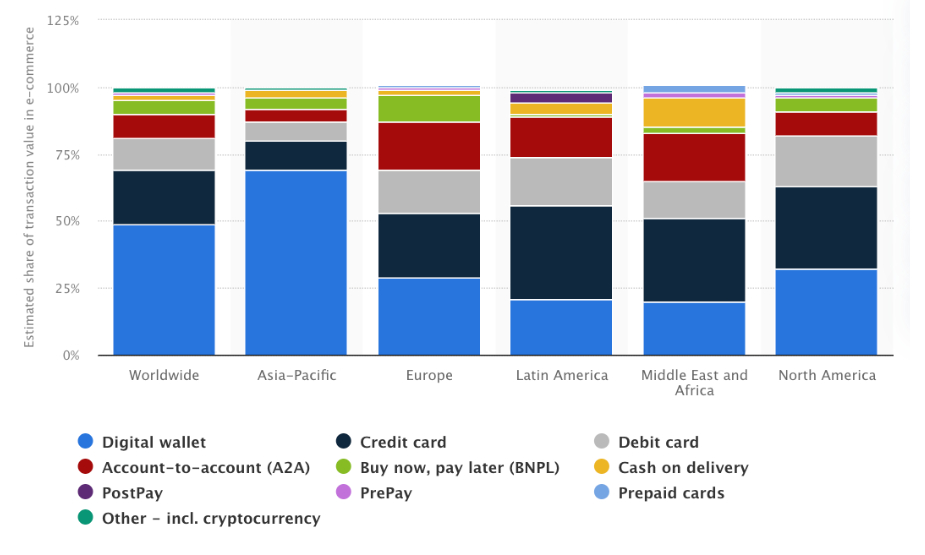Credit cards, digital wallets and more. Today, merchants have more choices than ever, but what’s the best option for your business?
Accepting the right payment methods is essential to eCommerce success. As online shopping behaviour evolves, businesses find themselves navigating a sea of online payment solutions. From traditional credit and debit cards to digital wallets, pay-by-bank and buy now pay later solutions.
Not Every eCommerce Payment Method Fits All
With global payment preferences shifting and regional nuances coming into play, it’s important for businesses to cater to diverse consumer preferences. By understanding and integrating the best payment solutions for your business, you’re enhancing the entire shopping experience.
Accept Credit Cards Online
When most merchants look for an eCommerce online payment solution, they’re thinking about credit card payment processing. This method was traditionally the go-to payment method for most online transactions. While its importance is undeniable, credit cards are one of many payment methods ecommerce businesses should accept.
In 2022, 60% of online purchases worldwide were made with digital wallets. Taken together, alternative payment methods made up 80% of ecommerce payments.
Source: Statista
Merchants Need a Cards Plus Solution
eCommerce payment processing services that offer a range of alternative payment methods give merchants the flexibility and reach to grow their sales and increase cart conversions. Here’s a look at some of the most popular alternative payment methods and what merchants need to know.
Why Accept Digital Wallet Payments Online?
Digital wallets are rapidly becoming the preferred payment method for many, especially members of Gen Z.
Apple Pay, Google Pay and other digital wallets store card data, so customers can complete transactions without having their credit card present. Others, like PayPal, Venmo and WeChat Pay, connect to users’ bank accounts.
Digital wallets can hold payment details from credit cards and debit cards so customers can make purchases online and in person without entering card numbers. Many can also hold various payment details, including gift card balances and coupons. Many wallets provide additional financial services like peer-to-peer transactions, bill payments, loans and financial services. Some of Asia’s most popular digital wallets, like WeChatPay and Paytm offer entire ecosystems of financial and consumer services to customers through a single app. These wallets are often referred to as Super Apps.
Advantages:
- Convenience: No more fumbling for cards or remembering lengthy bank details. Digital wallets enable payments through NFC, QR codes and click-to-pay.
- Security: With advanced encryption and tokenisation techniques, digital wallets ensure that your financial data remains protected from potential threats.
- Mobile Friendly: In an age where mobile commerce is on the rise, digital wallets are optimised for mobile transactions. This adaptability ensures that consumers can shop and pay on the go without any hitches.
Disadvantages:
- Adoption Rate: Not everyone’s on board the digital wallet train. Some consumers prefer traditional payment methods, especially in specific regions or age groups.
- Compatibility: Not all digital wallets are compatible with all devices, platforms, or merchants.
Does Your Payment Solution Support Your Customer’s Favorite Digital Wallets? Check Out Our Global Payment Guides to Find Out:
Why Accept Pay-By-Bank?
The pay-by-bank method is gaining momentum as a payment method preferred by both merchants and consumers. Rooted in open banking standards, Pay by Bank lets customers execute online payments directly from their bank accounts. This helps merchants with potentially lower fees and significantly diminishes the chances of chargebacks and fraud.
Customers opt for a “Pay by Bank” at checkout and are taken to their bank’s trusted online platform, where the transaction is approved and completed.
Advantages:
Cost Efficiency: Direct debit methods like “Pay by Bank” usually come with low transaction fees, making it more profitable for merchants.
Chargeback Protection: The threshold for initiating disputes is higher with “Pay by Bank”, giving merchants a stronger say in refunds. This is especially important for industries, like online gaming, and that experience a high number of Chargebacks.
Fast Transactions: In many countries, like the U.K. and Singapore, pay-by-bank combines with real-time payment networks, so merchants receive payment almost instantaneously.
Consumer Trust: Transactions via their bank’s interface enhance customer trust, especially for cross-border commerce.
Disadvantages:
Bank Dependency: Any technical glitches or downtime at the bank can impact transactions.
Limited Familiarity: Some customers might not be acquainted with this payment method.
Why Accept Buy Now, Pay Later Payments for eCommerce?
Gaining popularity, Buy Now, Pay Later (BNPL) allows consumers to purchase immediately and settle the bill in installments. This model empowers consumers with financial flexibility and encourages them to complete purchases they might otherwise abandon. Businesses like Kontempo have leveraged this trend, partnering with Rapyd to enhance their payment offerings.
Advantages:
- Flexibility: BNPL offers consumers the freedom to manage their finances on their terms. They can secure a product immediately and spread the cost over a period, making high-ticket items more accessible.
- Increased Sales: For merchants, BNPL can be a game-changer. By offering this payment flexibility, businesses often witness higher cart values, reduced cart abandonment and improved conversion rates.
Disadvantages:
- Debt Risk: While BNPL offers flexibility, it also comes with responsibility. Consumers who overextend themselves might find it challenging to keep up with payments, leading to potential debt accumulation.
- Fees for Merchants: BNPL solutions often come with higher fees for merchants. Merchants must weigh the advantages vs the costs to decide if BNPL is right for them.
Localize Payment Options for More Sales
According to Fintech Journal PYMNTS, “eTailers offering local payment options generate 22% more in regional revenue than those lacking these options, yet just 1.8% of merchants believe that customers desire these local methods.”
In global ecommerce, understanding and adapting to regional nuances is critical. These payment methods can range from local Digital Wallets like Paytm in India and GrabPay in Singapore to real-time payment networks like PIX in Brazil to accepting Diners Club credit cards in Latin America. With Rapyd, you can localise checkout with more than 900+ payment methods, ensuring your ecommerce purchase experience always feels local.
Advantages:
- Localised Experience: Offering local payment methods ensures that businesses cater to the unique preferences of consumers in specific regions, building trust and enhancing the overall user experience.
- Higher Conversion Rates: When consumers see familiar payment options, they’re more likely to complete their purchase. This can lead to reduced cart abandonment and higher sales.
- Broadened Market Reach: By embracing a variety of local payment methods, businesses reach market segments that might otherwise be inaccessible.
Disadvantages:
- Integration: Offering local payment methods can require integrating with and managing multiple ecommerce payment processing companies. Working with a company like Rapyd can simplify global payments.
Unlock Your eCommerce Potential with Rapyd
With Rapyd you can accept credit cards online plus boost sales up to 22% by localising checkout with popular local and alternative payment methods worldwide.
Global Reach: With Rapyd’s extensive network, merchants can cater to consumers worldwide.
One Integration. On with Your Day: Rapyd’s platform simplifies the integration process, allowing businesses to manage multiple payment methods through a single interface.
Security and Peace-of-Mind: With built-in Fraud monitoring and dispute management, Rapyd makes it easy for merchants to grow their business.
Optimise eCommerce






